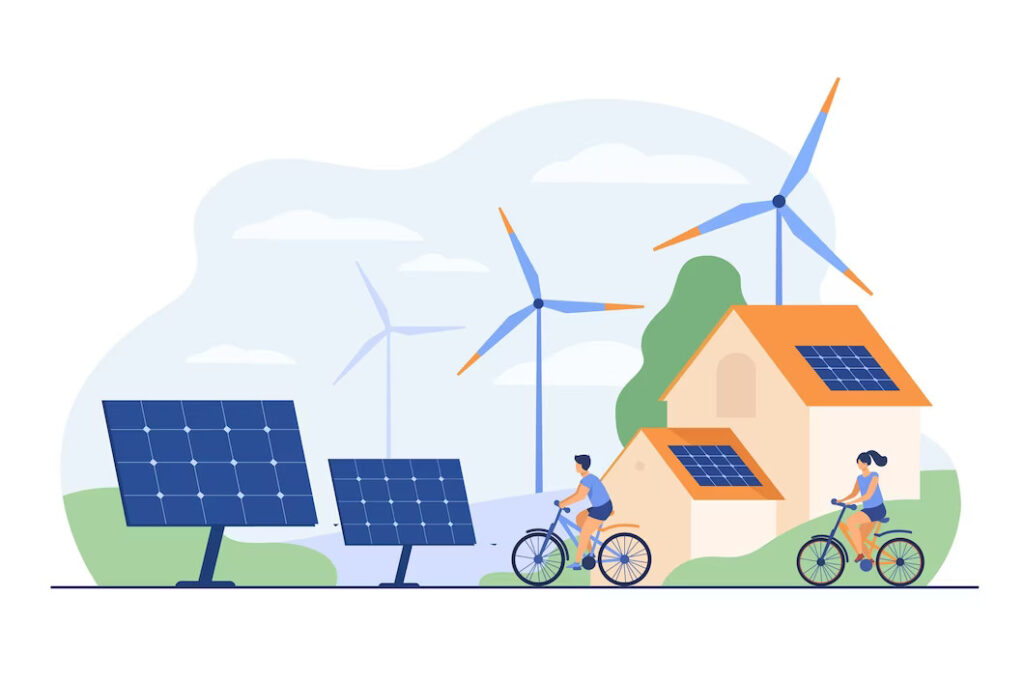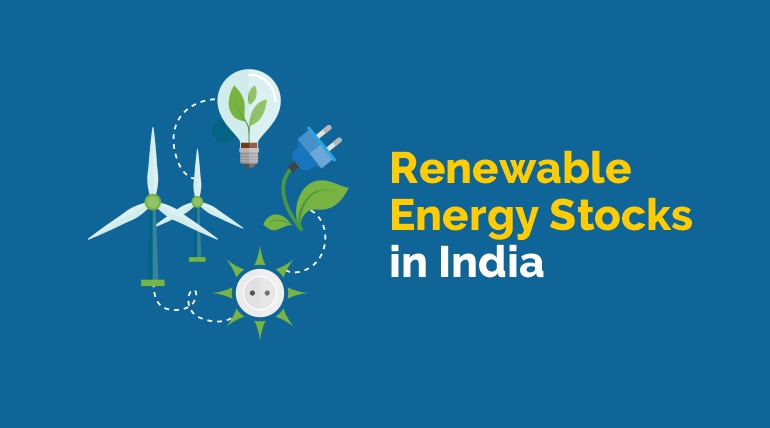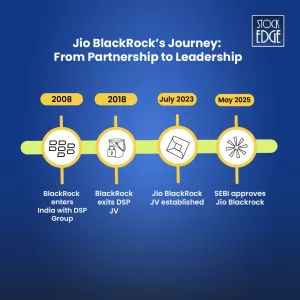Table of Contents
Renewable energy is gaining importance as the world becomes increasingly conscious of the urgent need to address climate change and reduce dependence on non-renewable energy sources. This has resulted in the development and implementation of various forms of renewable energy solutions such as wind, solar, hydroelectric, and geothermal power on a global scale.
With the growing demand for renewable energy, there has been a surge in the number of renewable energy stocks traded at the National Stock Exchange (NSE) and Bombay Stock Exchange (BSE) in India. These stocks have the potential to drive the economy towards a more sustainable future and support the transition towards a low-carbon future. With high potential comes the need of high amount of analysis of stock market.
With the growing demand for renewable energy, there has been a surge in the number of renewable energy stocks & EV stocks traded at the National Stock Exchange (NSE) and Bombay Stock Exchange (BSE) in India. These stocks have the potential to drive the economy towards a more sustainable future and support the transition towards a low-carbon future.
What is Renewable Energy?
Renewable energy is energy produced from natural, renewable resources that replenish themselves over time, such as sunlight, wind, rain, geothermal heat, and tides. Renewable energy technologies absorb and transform energy from these resources into usable energy, such as electricity or heat.
Renewable energy is seen as sustainable since it is obtained from constantly renewed resources, so it never runs out. Nonrenewable resources, on the other hand, such as fossil fuels (such as oil, natural gas, and coal ), are finite and will ultimately deplete.

Overview of Renewable Energy in India
The government has set ambitious goals for implementing renewable energy. In addition to these objectives, the government has adopted a variety of legislative incentives to promote renewable energy development, such as feed-in tariffs, tax breaks, and subsidies for renewable energy projects.
India has drawn tremendous investment in renewable energy in recent years, with domestic and foreign corporations engaging in renewable energy projects. This investment will continue in the following years, given the country’s increasing energy consumption, favorable policy climate, and robust economic development. This will benefit the Renewable energy stocks in India as a whole but it also important to search for individual stocks and analyze them accordingly.
Importance of Renewable Energy Stocks
- Diversification: Renewable energy stocks allow investors to diversify their portfolios. This is especially important in a market like India, where fossil fuels have historically dominated the energy sector. Investing in renewable energy stocks can help investors reduce their risk and volatility exposure in the traditional energy market.
- Environmental advantages: Renewable energy stocks in India allow investors to support companies working to make the world more sustainable and environmentally pleasant. Investing in renewable energy stocks can assist in driving a low-carbon economy and mitigating the effects of climate change.
- Government support: To encourage the growth of renewable energy, the Indian government has introduced a variety of policy incentives, including subsidies, tax exemptions, and other financial incentives. This assistance has contributed to the creation of a favorable climate for renewable energy enterprises, as well as to the sector’s growth. This will directly benefit renewable energy stocks.
Criteria for selecting the Top Renewable Energy Stocks
Financial performance
While examining renewable energy stocks, investors should consider many critical financial metrics. Here are some of the most factors financial aspects to consider:
- Revenue: Revenue is a significant measure of the financial performance of renewable energy stocks. Investors should search for organizations with a history of steady revenue growth, which indicates a high demand for the company’s products and services.
- Gross Margin: Gross margin is a vital indication of a company’s profitability since it gauges the difference between Revenue and COGS. Therefore, greater gross margins are typically a good indicator since they imply that the company can earn more profit per unit of revenue.
- Debt-to-Equity Ratio: The debt-to-equity ratio is a financial leverage indicator computed by dividing a renewable energy stock’s total debt by its equity. A more significant debt-to-equity percentage signifies that the company depends more heavily on debt to finance its operations, which can be a symptom of heightened risk.
- Cash Flow: A company’s ability to create cash from its activities is measured by its cash flow. Investors should search for businesses with positive cash flow since it suggests that the company can support its operations and investments without relying on outside financing.
Growth potential
India’s renewable energy sector is quickly expanding, with tremendous room for expansion in the future. Consequently, renewable energy stocks in India can create substantial returns for investors who can spot and capitalize on the correct chances. And to encourage the growth of renewable energy, the Indian government has introduced a variety of policy incentives, including subsidies, tax exemptions, and other financial incentives. This assistance has contributed to the creation of a favorable climate for renewable energy enterprises, as well as to the sector’s growth which will directly benefit renewable energy stocks. Identifying the top stocks in this sector might be daunting, therefore, it is extremely important for an investor to do effective research with a stock market analysis tool to make more informed decisions.
Top Renewable Energy stocks in India
NTPC (National Thermal Power Company) Ltd
Company Overview
NTPC (National Thermal Power Company) Ltd, with its subsidiaries, partners, and joint ventures, is principally involved in generating and selling bulk power to state power utilities. The group’s other businesses include consultation, project management and supervision, energy trading, oil and gas exploration, and coal mining. And it wants to expand its non-fossil fuel asset concentration from 7% of total capacity to 30% by 2032. As of today’s date, this is NTPC share price
Financial performance
- Consolidated sales were Rs 446 billion in Q3FY23, up 34% year on year, while EBITDA was up 31.5% year on year at Rs145bn. The reported consolidated PAT was Rs 48.5 billion (+4.9% YoY) during the adj.
- PAT was up 16.6% YoY at Rs 48bn, despite a 21.1% YoY decrease in other income to Rs 3.9 billion, mainly owing to decreased surcharge income.
- Nevertheless, incentives were Rs 1.25 billion in Q3FY23 and Rs 4.24 billion in 9MFY23 (vs. Rs 3.2 bn in 9MFY22). As a result, profit from subsidiaries fell to Rs 12.9 billion in 9MFY23 (from Rs 13.9 billion in 9MFY22).
- In contrast, NTPC’s share of JV earnings fell to Rs4.8 billion in 9MFY23 (from Rs8.3 billion in 9MFY22), owing to LPS reduction, debtor discounting, and modifications in accounting for future receivables.
- Dividend income from subsidiaries and joint ventures was Rs10.46 billion in 9MFY23, compared to Rs11.42 billion in 9MFY22.
Tata Power Company Ltd
Company Overview
Tata Power Company Limited primarily engages in power generation, transmission, and distribution. It intends to generate all of its power from renewable sources. It also makes solar roofing and wants to construct 1 lakh electric vehicle charging stations by 2025. In the future, the company hopes to achieve a clean and green portfolio of 80% by 2030 and 100% by 2045 and develop through low-carbon enterprises. As of today’s date, this is Tata Power Company share price
Tata Power Company is a part of Nifty Next 50 Indices
Financial performance
- TPWR’s reported revenues (consolidated) increased 31% year on year to Rs 143.6 billion, while said consolidated PAT grew 91% year on year to Rs 10.5 billion (TPWR’s share of profit increased 122% year on year to Rs 9.5 billion).
- The underlying EBITDA was Rs 38.2 billion, rising 53% year on year. The main factors influencing Q3FY23 performance were:
- Good performance of all discoms due to higher power demand (Odisha discoms posted a cumulative profit of Rs 350 mn).
- Higher profit from CGPL + coal companies on both QoQ and YoY basis as CGPL sold power under Section-11 of the Electricity Act and CERC allowed full fuel cost pass-through, reducing fuel cost under-recovery to nil.
- Increased RE capacity (962MW installed in the last 12 months) and strong growth in all RE companies resulted in a 48% YoY profit increase for the consolidated green sector at Rs1.4bn.
- Net debt was Rs381 billion at the end of Q3FY23. Although receivables were high (but under control) at Rs84.7 billion, they were lower than the Rs93.6 billion recorded in Q2FY23.
Borosil Renewables Ltd
Company Overview
Borosil Renewables manufactures ultra-clear patterned glass and low-iron solar glass for use in photovoltaic panels, absorber plate collectors, and green homes. In addition, BRL manufactures low-iron solar glass for use in photovoltaic panels.
They are the country’s first and only maker of solar glasses. The Company’s thinner, completely tempered solar glass (2mm and 2.5mm) fills a niche market for glass modules. As of today’s date, this is Borosil Renewables share price
Financial performance
- Volume climbed by 3% year on year in Q3FY23, but realization fell 5% year-on-year to INR134.3/sqmm. Hence, revenue fell 4.2% year on year to INR1,614 million, with export revenue accounting for INR580 million (35.9% of total sales).
- The cost of materials consumed and fuel expenditures increased by 30% and 38% year on year, respectively, due to rising naphtha, gas, soda ash, and electricity prices. Due to severe competition from Chinese competitors, notably following the reduction of anti-dumping duties on imported Chinese solar glass, BRL could not pass on the increased input costs to its consumers.
- As a result, EBITDA fell 52% year on year to INR335mn, while the margin shrank 2061 basis points to 21%. PAT fell 51% year on year to INR225 million.
KPI Green Energy Ltd
Company overview
KPI supplies solar electricity to captive power producers (CPP) consumers as an independent power producer (IPP) as well as Procurement, Engineering, and Construction (EPC) services. The company’s whole operation is based in Bharuch.
Today, the business has 100 MW of solar power installed capacity within the IPP sector and 100 MW+ of EPC/CPP projects. In Gujarat, the company offers solar energy through third-party sales. It builds and manages grid-connected IPP solar power plants using the’ Solarism’ brand. Using Power Purchase Agreements, the company provides power generated by solar power facilities to businesses (PPA). As of today’s date, this is KPI Green Energy share price
Financial performance
- In Q3FY23, the company saw increased revenue from operations and profit margins. The third quarter of FY23 continued the trend of growth from the previous two quarters of FY23, with the total income of the company increasing significantly in terms of revenue from operations from Rs 6,240 lakhs in Q3FY22 to Rs 17,966 lakhs in Q3FY23, reflecting an incredible growth of 188% YoY, 12% compared to the previous quarter Q2FY23, and 46% compared to Q1FY23.
- As a result, the overall income recorded for the 9MFY23 is Rs 46,262 lakhs, compared to Rs 15,579 lakhs in the same 9M FY22, representing a 197% growth on a 9-month basis.
- Captive Power Project (CPP) sales increased from Rs 4,651 lakhs in Q3FY22 to Rs 15,154 lakhs in Q3FY23, representing a 226% increase. As a result, the income from Power Sales (IPP) increased by 77% from Rs 1,521 lakhs in Q3FY22 to Rs 2,695 lakhs in Q3FY23.
- The IPP income for Q3FY23 increased to Rs 2,695 lakhs from Rs 17,14 lakhs in Q2FY23. This was mainly due to increased power generation due to enhanced radiation following the end of the monsoon season. Due to an increase in IPP capacity, the 9MFY23 was at Rs 6,342 lakhs as opposed to Rs 3,919 lakhs in the 9MFY22.
- As a result, the current quarter’s consolidated net profit climbed dramatically to Rs 3,446 lakhs, representing 19.18% of total sales, compared to Rs 1,314 lakhs, or 13.21% in Q3FY22. The consolidated net profit for 9MFY23 is an all-time high of Rs 7,785 lakhs, up from Rs 3,338 lakhs in 9MFY22.
Conclusion
Finally, the renewable energy industry in India is continuously increasing and evolving, providing an excellent opportunity for investors interested in environmentally sensitive and sustainable investments. The renewable energy sector is predicted to develop rapidly in the following years, thanks to the Indian government’s commitment to decreasing greenhouse gas emissions and attaining a target of 450 GW of renewable energy capacity by 2030.
Investing in renewable energy stocks can allow you to participate in the sector’s growth while helping create a greener, cleaner, and more sustainable future. Yet, because the renewable energy business may be very competitive and unpredictable, investors must exercise caution and thoroughly analyze individual companies.
The company’s financial health, portfolio of renewable energy projects, track record of project execution, and strategic plans for development and expansion are all critical variables to examine when analyzing renewable energy stocks. Furthermore, investors should evaluate the regulatory framework and government policies that may influence the renewable energy market.
Overall, renewable energy stocks are a valuable addition to an investing portfolio, allowing participation in a sustainable and expanding industry while earning significant returns.
Note: NTPC and Tata Power Ltd have a high debt-to-equity ratio, which means they have a high portion of debt in their balance sheet, and the reason is that they are investing heavily in Fixed Assets, which is justified by the cash flow statement, ie. Cash flow from investing and financing activity. And both the company is in a capital-intensive business, so they finance their capex with the debt and internal accruals to maintain a healthy return on capital for the investors, which is decided by the management.
However, as with such companies, various risks are associated, which can impact the Company’s performance.
So, we suggest you track them on a quarter-on-quarter basis in the upcoming year (2023) and also track the Edge Report section for any premium reports from our StockEdge Analysts. We would also advise consulting your SEBI registered investor before investing in any of these.
Until then, keep an eye out for the next blog on “Stock Insights.” Also, please share it with your friends and family.
Happy Investing!











